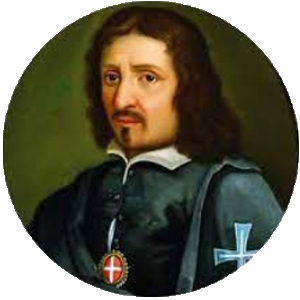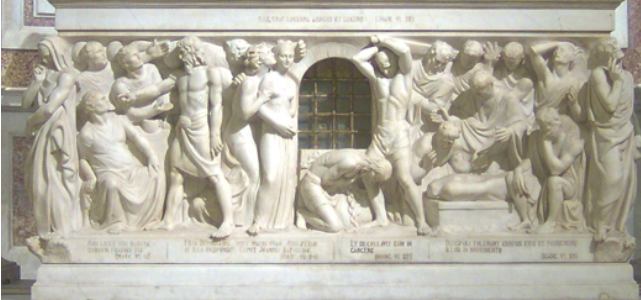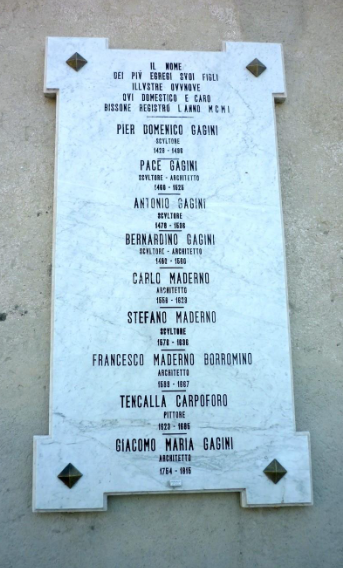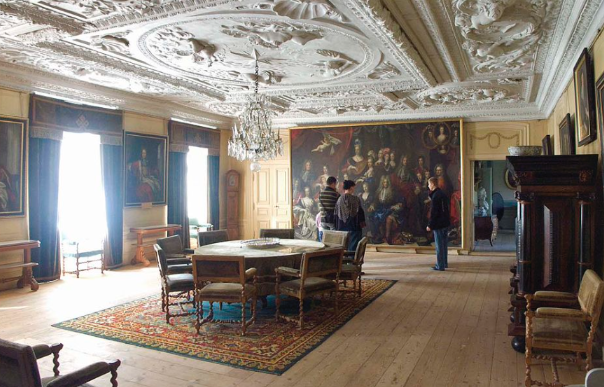Artists
Bissone is known throughout the world for being the birthplace of illustrious figures in European art history. The first to bring glory to this small riverside village was the sculptor Giovanni Bono, who in 1281 created the two-storey portico on the façade of Parma Cathedral. From then on, entire families of artists contributed, for generations, to the construction and embellishment of churches and palaces throughout Europe, starting in the 13th century. Architects, sculptors, painters and stucco artists in the service of emperors, high prelates and noble families left evidence of their creative abilities everywhere. The best known is certainly Francesco Castelli, better known as Borromini, the architect who enriched Rome with unparalleled masterpieces in the 17th century. But others, too, with their skill, upheld the name of Bissone among the most prestigious European courts: the Bono, Maderno, Gaggini, Somaini, Tencalla, Garovi, Garovaglio, Bussi, Caliari, Orsatti families and others. United in teams, often reinforced with workers from neighbouring municipalities or the Intelvi Valley, they built and decorated buildings from Italy to Czechoslovakia, from Spain to Hungary and, during occasional returns to their homeland, the houses of their native village.

Francesco Castelli known as Borromini
(1599-1667)
The Gaggini family
Very well-known in Liguria, Sicily and Spain, the Gaggini family left everywhere evidence of their art right from the middle of the 15th century. Their progenitor was Beltrame Gaggini (?-before 1476), an architect, from whom came Antonio, Pace and Pietro. Giovanni and Antonio worked as architects and sculptors mainly in Genoa, while Pace (1460-1525) was the designer of superb works on the façade of the Certosa di Pavia, where he worked for his uncle Antonio della Porta. Having gone to Seville, he carved the large monument to countess Catalina de Ribera which can be admired in the university church.
Domenico Gaggini (1426-1492) worked as sculptor in Genoa, Naples and Palermo. But it was primarily in Sicily that his workshop had great success and was carried on by his children, grandchildren and so on until ca 1750. They achieved considerable fame as sculptors, plasterers and goldsmiths. Notably, his son Antonello (1478-1536) achieved great success all over Sicily and in the south of Italy by making statues, bas-reliefs, funeral monuments and other kinds of sculpture.

Antonello Gaggini, Madonna of the Ladder, Palermo Cathedral, 1503

Domenico Gaggini, Cathedral of San Lorenzo, Genoa, 1447-1456 (detail)

Epigraph by Bissone artists placed on the north facade of the church of San Rocco
The Garovi/Garovaglio family
The large members of this family of artists covered a period of over 200 years, from the start of the 16th century to the middle of the 18th century. As architects, sculptors, plasterers and painters, the Garovi family left evidence of their art all over Europe, from Italy to Portugal, from the Czech Republic to Austria, from Germany to Sweden. They built castles, noble palazzos, baptisteries, public buildings, decorated with stucco façades, ceilings, funerary chapels and painted frescoes on church and cathedral vaults.
The marriage in ca. 1550 between Simone Garove and Simona Allio di Scaria (Intelvi Valley) gave rise to the Garovaglio branch of the family. Family relations with members of the Tencalla and Castelli (Borromini) families boosted the formation of crews, who would be joined, according to their needs, by workforce coming from nearby villages.

Carlo Garovi (1630-1697), stucco in Nynäs Castle, Sweden.

Andrea Simone Garovi (1652-ca. 1717), directed the construction of the Winter Palace of Prince Eugene of Savoy, in Vienna.
The Tencalla family
The Tencalla family were active mainly in the 17th and 18th centuries respectively, leaving works not only in the native village, but in a number of European districts and cities: notably in Wien (Austria), Vilnius (Lithuania), in Moravia, Poland, Bavaria, Veneto, Lombardy, Rome. Among the eminent members of this family of painters, plasterers, sculptors and architects, Cristoforo Tencalla (1623-1685) was certainly a leading exponent.
Aged little more than 20, he started painting frescoes in Slovakia, and later on in Wien, where he decorated the palazzos of aristocratic families and churches. His fame secured him the accolade of court painter by the wife of the Emperor Ferdinand II of Habsburg. He subsequently received many commissions that resulted in him working in Moravia and Hungary, too.
Other members of the Tencalla family stood out as architects: Costante Tencalla (1590-1647) in Poland, his son Giovanni Pietro (1629-1702) in Austria and the Czech Republic, his brother Giovanni Giacomo (1591-1653), in Vienna and Moravia.

St. Stephen’s Cathedral, Passau (D): facade

St. Stephen’s Cathedral, Passau (D): frescoes by Carpoforo Tencalla

